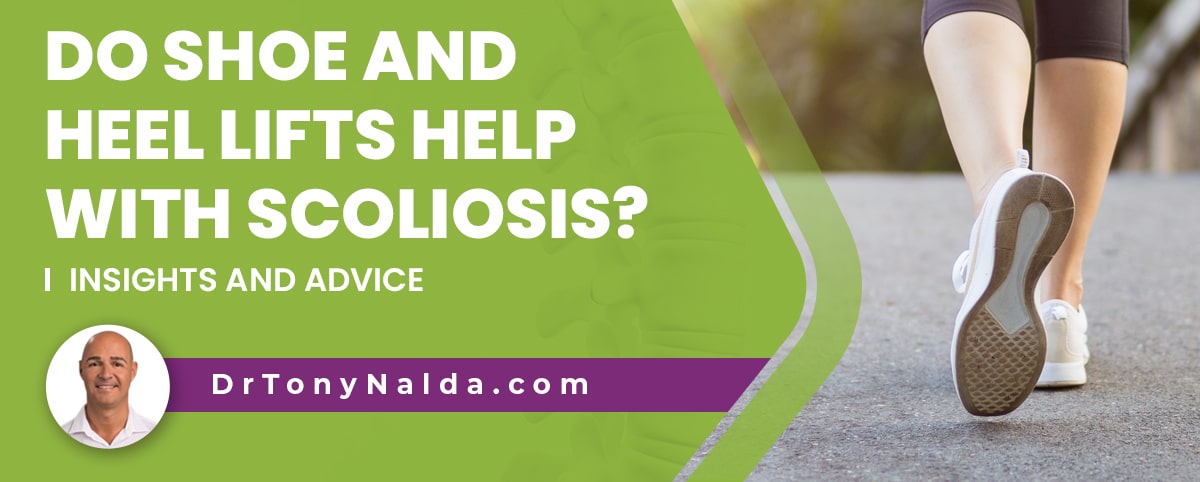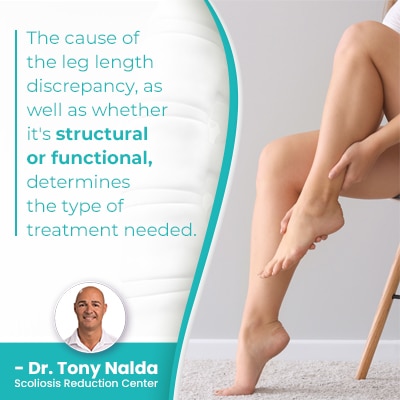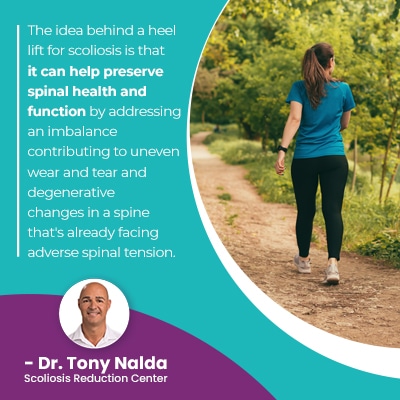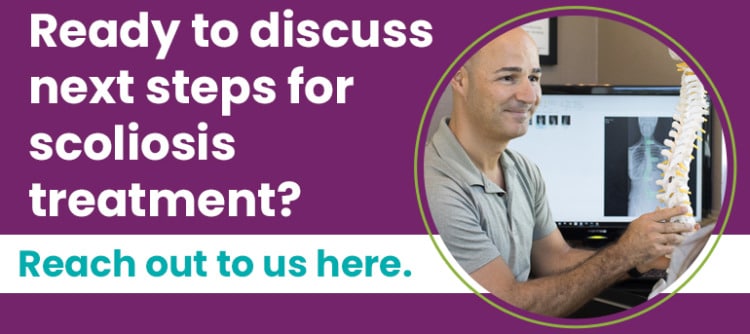Do Shoe and Heel Lifts Help with Scoliosis? Insights and Advice

Scoliosis introduces uneven forces to the body and can have a number of effects, including postural changes that disrupt the body's overall symmetry. Uneven shoulders, hips, and arms and legs that appear to hang at different lengths are common. Leg length discrepancy can have different causes.
Shoe and heel lifts can help with scoliosis by correcting asymmetries in the body, restoring posture, and pain relief. Custom foot orthotics can address leg length discrepancy, but it has to be determined whether the different leg length is structural or functional.
Before getting to the specifics of shoe and heel lifts for scoliosis, let's explore how scoliosis affects the body generally.
Table of Contents
Scoliosis Effects
Scoliosis causes the spine to bend unnaturally to the side and rotate, and this introduces a lot of uneven forces to the body, and as a progressive condition, those forces can increase over time as the size of the unnatural spinal curvature is likely to increase.
Growth triggers progression, so childhood scoliosis should always be taken seriously, and the more severe scoliosis is, the more noticeable its effects are going to be.
Scoliosis doesn't just affect the spine, but also its surrounding muscles, nerves, and the symmetry of the entire body.
A misaligned spine means a misaligned body, particularly when postural changes are occurring.
Scoliosis also tends to affect the area of the body located the closest to the affected spinal section, so when it comes to changes in leg length, this can be most closely associated with lumbar scoliosis as its effects are largely felt in the lower body and lower extremities.
To treat scoliosis, the structural nature of the unnatural spinal curve has to be addressed because it's the underlying cause of the condition's uneven forces.
Common postural changes can include uneven shoulders, hips, the development of a rib cage arch, arms and legs that appear to hang at different lengths, and these types of changes also contribute to movement changes: balance, coordination, and gait.
So if an effect of scoliosis involves uneven leg length, shoe inserts may be an option.
Scoliosis and Shoe Lifts
If a leg length discrepancy is detected in a scoliosis patient, it can be structural or functional.
A structural leg length discrepancy involves an actual structural difference in leg length, while a functional leg length discrepancy is caused by movement issues.
Scoliosis causes changes to gait; if the head isn't centered over the torso, this extends down the body and can mean the trunk isn't centered over the pelvis, and this can cause the development of an uneconomical gait.
If uneven hips develop, one can sit higher than the other, causing the leg on the same side to be held higher: more of a functional discrepancy.
 The cause of the leg length discrepancy, as well as whether it's structural or functional, determines the type of treatment needed.
The cause of the leg length discrepancy, as well as whether it's structural or functional, determines the type of treatment needed.
Structural Leg Length Discrepancy
When a difference in leg length is structural, one leg is actually shorter than the other, and in these cases, the asymmetry is permanent and won't change with movement or changes to position.
A custom orthotic or shoe lift can address the structural difference in leg length by evening the length and removing the asymmetry.
A custom orthotic can help keep the spine and body more aligned, and a body and spine that's in balance is one that's going to function better.
A true structural leg length discrepancy can be congenital, meaning babies are born with the discrepancy due to one femur bone not growing properly in utero.
Structural leg length discrepancy can also be caused by trauma to a leg's growth plate, causing it to grow slower, and degeneration caused by arthritis is another cause; arthritis can cause a loss of space between the hips or knee.
Cancer eroding bone can also cause a structural difference in leg length.
Functional Leg Length Discrepancy
A leg imbalance that's functional is caused by an asymmetry found elsewhere in the body and/or a disruption in the position and alignment of the pelvis and lower body.
It can also be caused by excessively-tight muscles, ligaments, tendons, muscular imbalance, trunk instability, foot pronation, and scoliosis.
Scoliosis causes postural changes that mean the body isn't aligned and can cause differences in movement capable of disrupting leg length symmetry.
So while scoliosis can cause differences in posture and movement capable of making one leg appear shorter than the other, the difference isn't structural, so the underlying cause of the asymmetrical movement has to be addressed: the scoliosis itself.
Treatment that reduces the size of the unnatural spinal curvature and improves the spine's surrounding muscles strength and balance can restore posture as the spine's balance and alignment are restored.
Choosing A Shoe Lift for Scoliosis
So structural leg length discrepancy can be improved by the right shoe lift, and here at the Scoliosis Reduction Center®, a specific X-ray is performed, and a number of comprehensive measurements are taken, to determine whether the difference is structural or functional.
A structural leg length imbalance can be improved by a custom orthotic that can facilitate a more economical gait and symmetrical posture.
Proactive treatment that addresses the structural nature of the scoliosis and a custom orthotic device can help restore the spine and body's balance and support proper balance, movement, and posture.
In functional cases, a shoe lift for scoliosis may help slow progression by improving the imbalance that can further disrupt gait and movement, causing uneven wear and tear on the spine and degenerative changes.
Improving an imbalance can also provide pain relief as the body's symmetry is improved.
When an imbalance of less than 1.5 centimeters is detected, lifts aren't commonly prescribed, but when a leg length inequality of more than 1.5 centimeters is affecting a scoliosis patient, a shoe lift can help when scoliosis has caused an unnatural pelvic tilt.
 The idea behind a heel lift for scoliosis is that it can help preserve spinal health and function by addressing an imbalance that's contributing to uneven wear and tear and degenerative changes in a spine that's already facing adverse spinal tension.
The idea behind a heel lift for scoliosis is that it can help preserve spinal health and function by addressing an imbalance that's contributing to uneven wear and tear and degenerative changes in a spine that's already facing adverse spinal tension.
Reducing stress on a scoliotic spine may also help slow progression, and foot orthotics can help improve scoliosis pain involving the back and hips.
Addressing a Scoliosis Leg Length Discrepancy With Treatment
When a leg length is caused by postural and movement changes caused by scoliosis, the condition itself has to be addressed, as the leg length inequality is a symptom of the condition's uneven forces.
Heel lifts work by addressing the asymmetrical difference in leg length, but remember, if the unnatural spinal curve is the underlying cause of that asymmetry, the spine's structural abnormality has to be addressed for any type of long-term solution.
Here at the Center, patients benefit from a conservative treatment approach that involves integrating multiple types of nonsurgical treatment options capable of impacting scoliosis on every level and preventing further curve progression.
Chiropractic adjustments can work towards improving the spine's structural alignment, and physical therapy and scoliosis-specific exercises can help improve the spine's surrounding muscle balance and strength for more spinal support and stability, along with postural restoration.
A spine that's more aligned and supported is one that can facilitate healthy posture and body positioning, along with symmetrical movement.
Conclusion
So do shoe and heel lifts help with scoliosis? In some cases, custom foot orthotics can help with pain caused by asymmetrical postural and movement changes, and they can also help by slowing progression by preventing degeneration caused by uneven wear and tear on the spine.
There are different types of leg length discrepancies. A difference in leg length can be structural or functional: caused by an actual structural difference in leg length, or a difference caused by asymmetrical movement or an asymmetry elsewhere in the body, like the pelvis.
When a leg length inequality is structural, heel lifts can help by making the legs equal lengths which can help with movement and gait, and when a leg length discrepancy is functional, they can help by facilitating more symmetrical movement, improving posture and wear and tear on the spine caused by asymmetrical movement.
As a common effect of scoliosis involves a pelvic tilt caused by the torso being uncentered over the lower body, the spinal condition can also cause the effect of a leg length inequality.
It's important for patients to understand, however, that while a custom orthotic can help with symptom relief and improving uneven forces introduced to the spine, it can't treat scoliosis on its own; only a proactive treatment plan can truly correct scoliosis for long-term pain relief and treatment results.
All cases of scoliosis need to be taken seriously. As a progressive condition triggered by growth, the best time to start treatment is always now, and while addressing a leg length inequality with orthotics can help with pain and movement, when scoliosis is the cause, the scoliosis needs to be addressed proactively.
Dr. Tony Nalda
DOCTOR OF CHIROPRACTIC
After receiving an undergraduate degree in psychology and his Doctorate of Chiropractic from Life University, Dr. Nalda settled in Celebration, Florida and proceeded to build one of Central Florida’s most successful chiropractic clinics.
His experience with patients suffering from scoliosis, and the confusion and frustration they faced, led him to seek a specialty in scoliosis care. In 2006 he completed his Intensive Care Certification from CLEAR Institute, a leading scoliosis educational and certification center.
About Dr. Tony Nalda
 Ready to explore scoliosis treatment? Contact Us Now
Ready to explore scoliosis treatment? Contact Us Now





